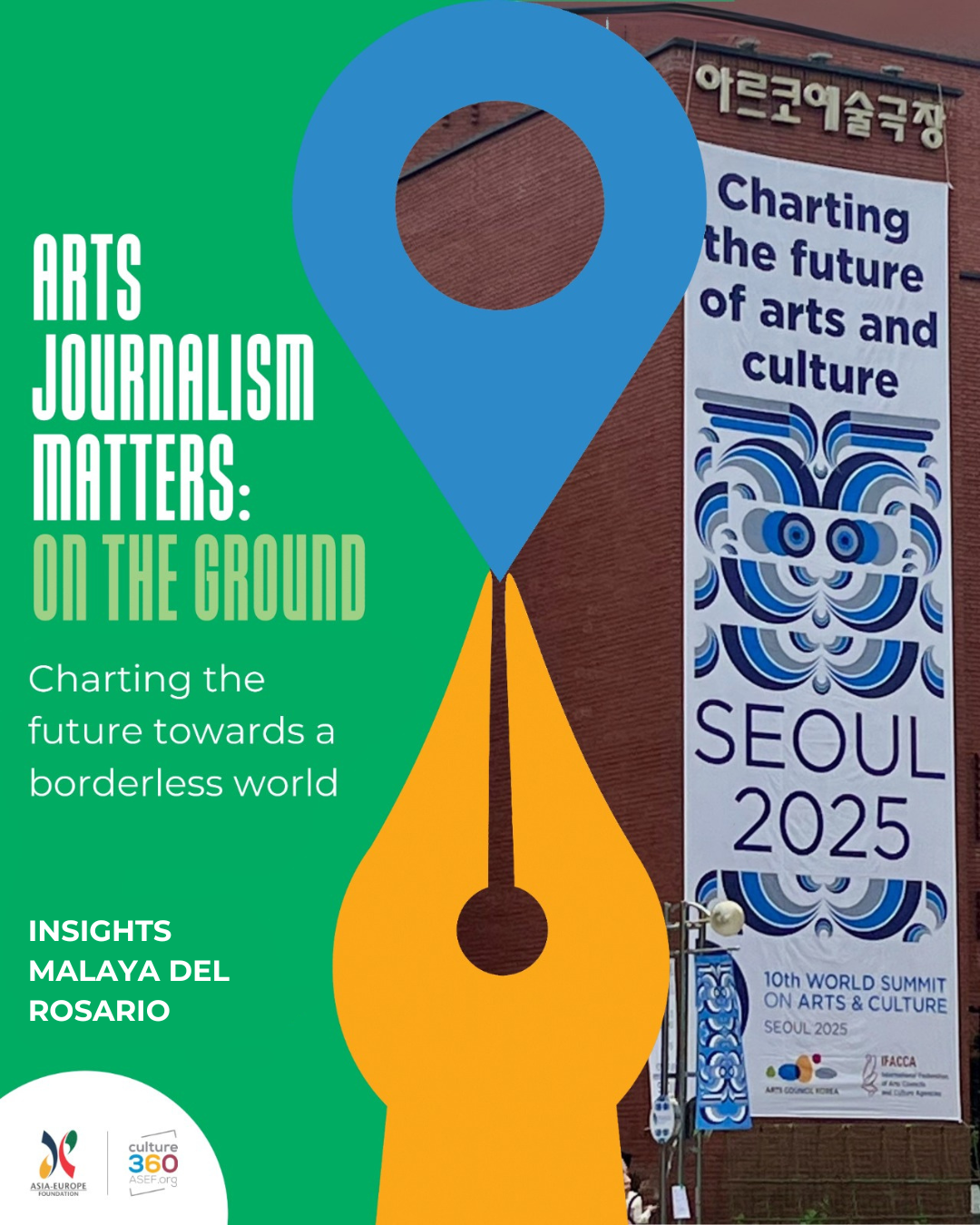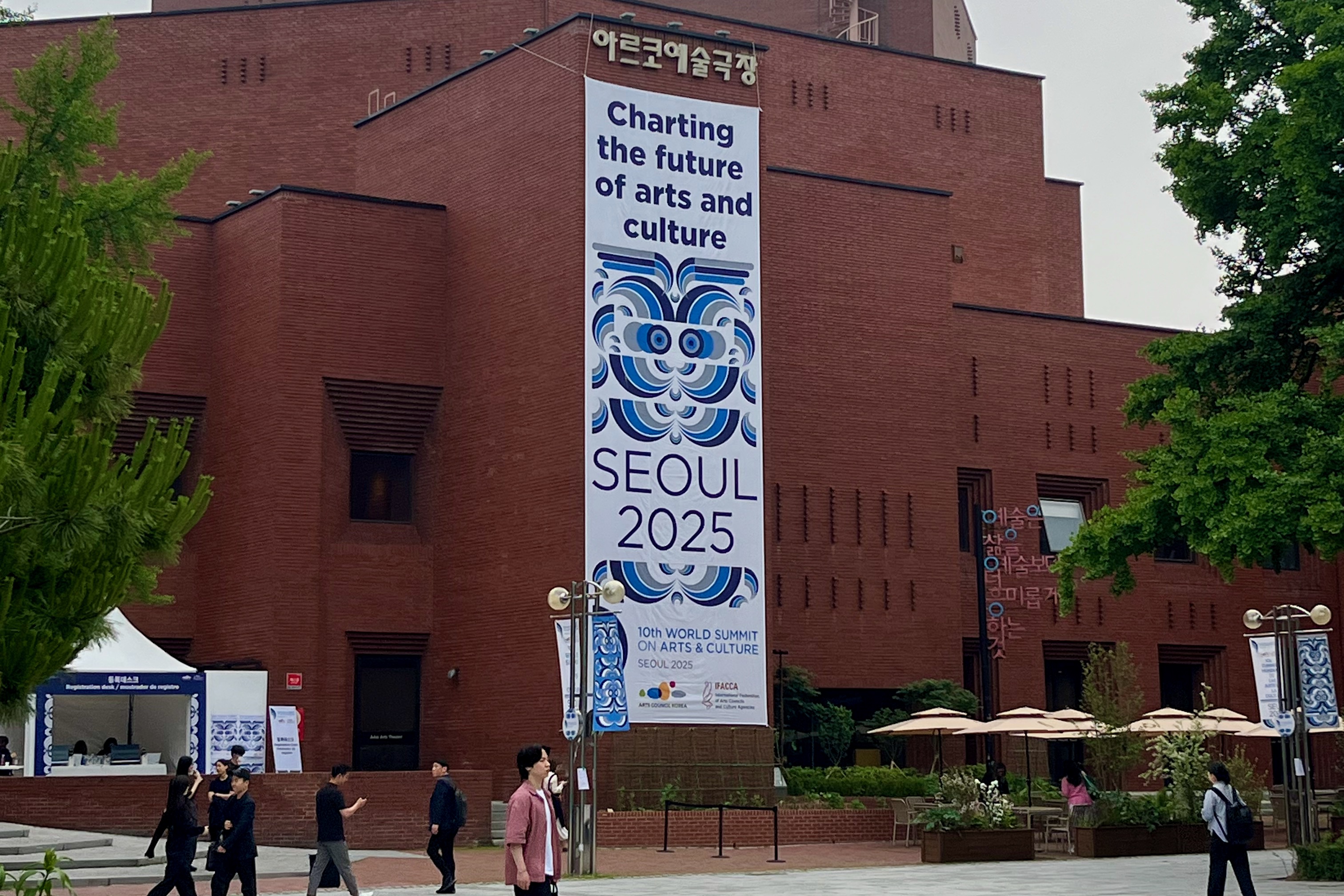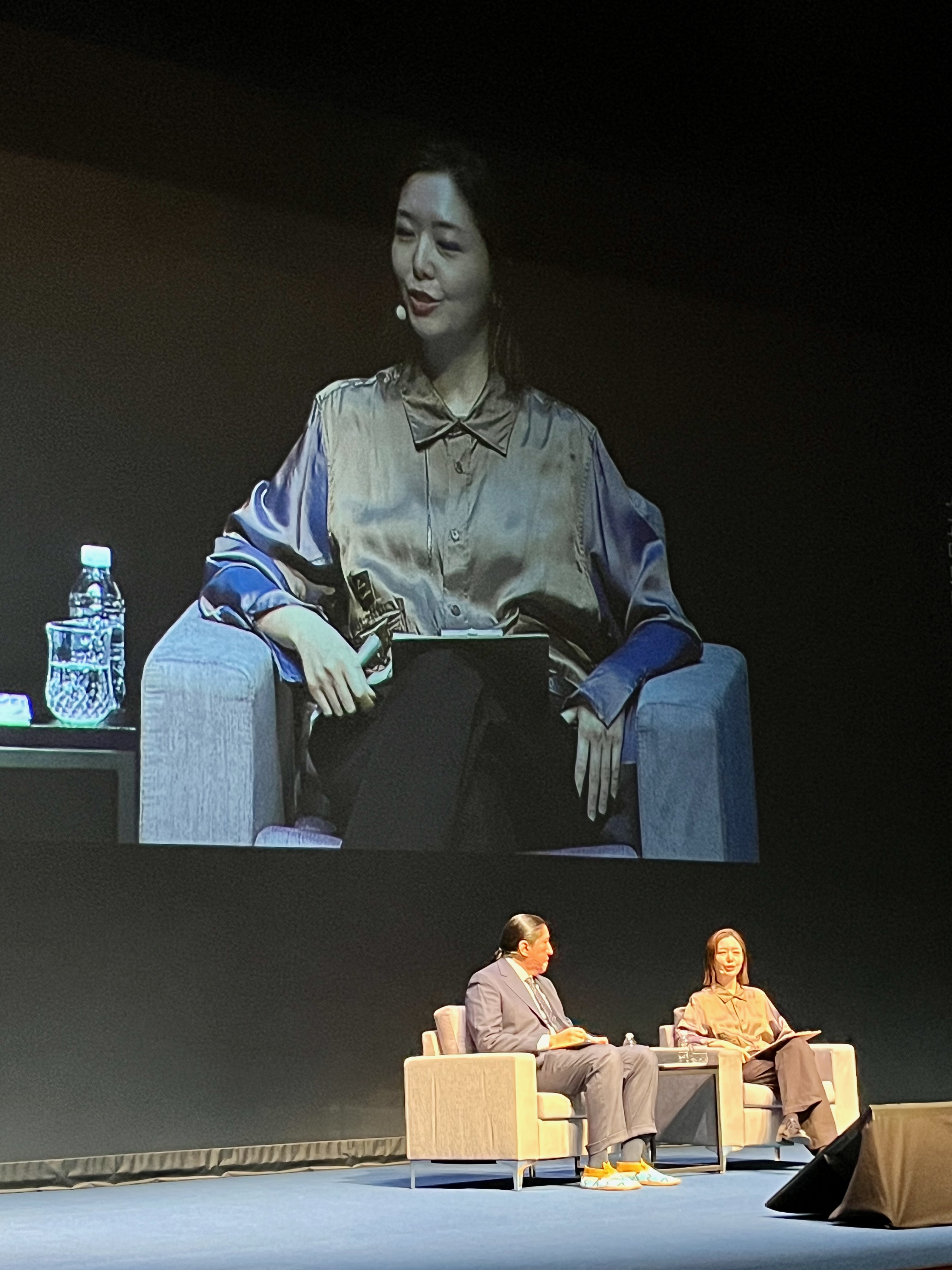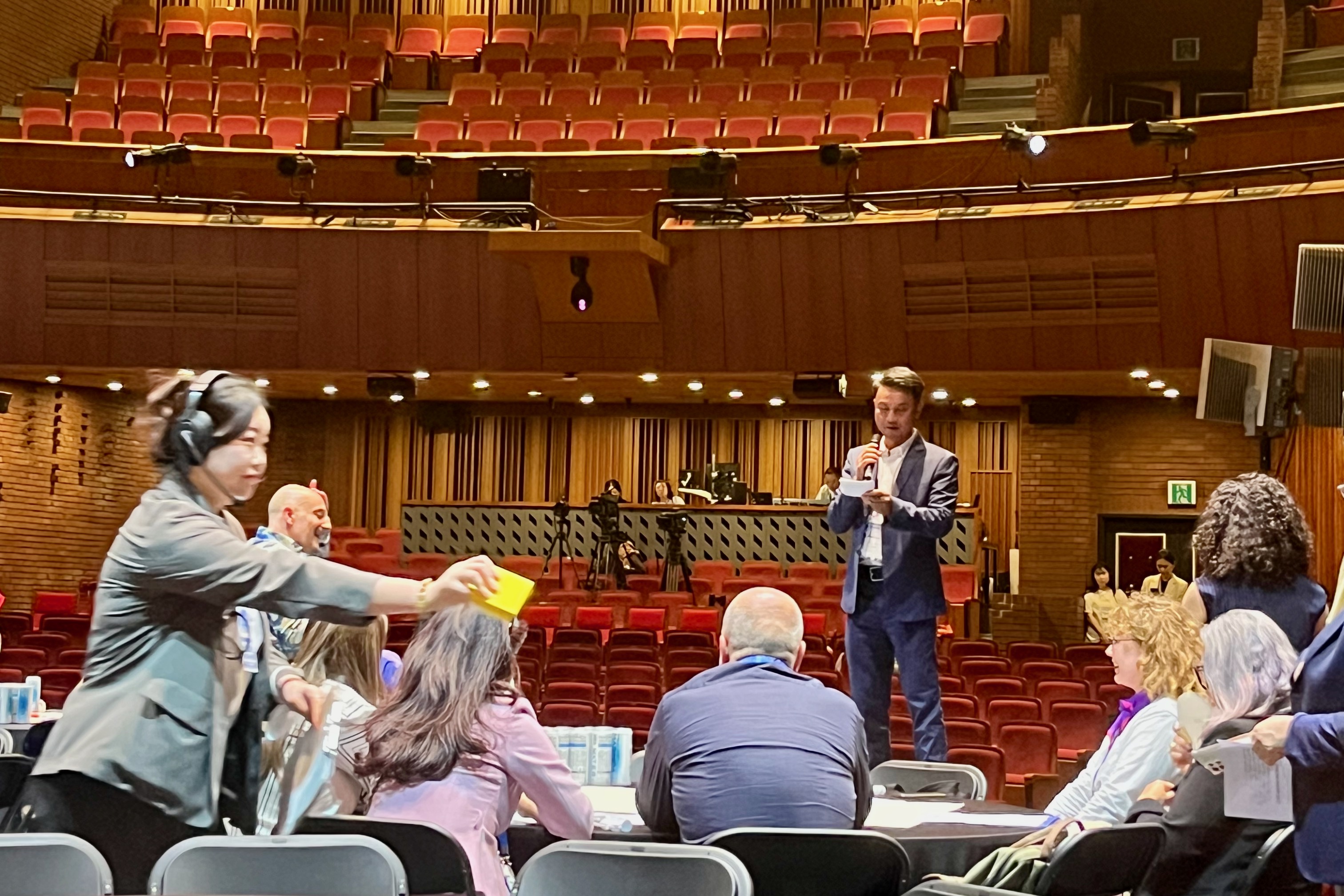Charting the future towards a borderless world: Insights from the World Summit on Arts and Culture

From the global rise of the Korean Wave to new frontiers in cultural policy making, Malaya del Rosario attended the 10th World Summit on Arts and Culture in Seoul to document how the arts and cultural sector is navigating change. She joined as an Arts Journalism Matters: On the Ground Fellow with the Asia-Europe Foundation (ASEF).
Just a few decades ago, South Korea was transitioning into a democracy, rebuilding its economy and cultural institutions. Today, it is a powerhouse of global cultural influence with its creative industries fuelled by digital innovation and the Korean Hallyu (the ‘K-wave’) phenomenon. But the country has also grappled with social tension, censorship, and rapid technological change, making it an ideal setting to reflect on the promises and pitfalls of cultural globalisation.
1. The 10th World Summit on Arts and Culture at ARKO Arts Theatre, Seoul. Photo © Malaya del Rosario
The 10th World Summit on Arts and Culture was held in Seoul from 27-30 May 2025. Organised by the International Federation of Arts Councils and Culture Agencies (IFACCA) and Arts Council Korea and brought together cultural ministers, leaders, and artists from around the world. With the title “Charting the future of arts and culture,” it focused on how culture is responding to disruption on multiple fronts.
As United Nations Special Rapporteur Alexandra Xanthaki put it, "multilateralism is in crisis”. In many developed countries, international cooperation funding has been slashed, impacting development aid and cross-cultural exchanges. Meanwhile, digital technologies have altered how we create, collaborate and disseminate content across the world.
Just like the Korean Hallyu, a wave of calls emerged across discussions during the Summit. The most resonant of all is a desire for a more borderless future that is shaped by equity, imagination and empowerment. How achievable is such a world?
1. A call for equity
Various sessions focused on how today’s technologies are reinforcing social, economic and political divides. As one participant shared:
You can take away AI as an issue and what you have left with is inequality.
This was echoed by AI ethicist and poet Michael Running Wolf, who shared his work on a language model developed with and for Indigenous communities, First Languages AI Reality. With over 3,000 endangered languages globally (UNESCO, 2024), he argued that these cultural ‘data’ are still excluded from large language models. He then called for solutions grounded in community engagement and trust rather than those reliant on developing new, costly, energy-intensive technology.
Data is like land, he said: it requires consent, care, and fair compensation but is often exploited without adequate recognition or benefit to those who steward it.
Meanwhile, on the African context, consultant and researcher, Yarri Kamara, spoke about how cultural policy is increasingly being framed through the lens of economic opportunity. While this has helped secure support for the creative industries, it has raised difficult questions: What happens to artists and practices that cannot compete in commercial markets? What happens when access is reserved only for those who can pay? Yarri urged policymakers to build frameworks that reflect the broader social value of culture, not just its market potential.
2. Imagination in action
Throughout the Summit, speakers also shared different examples of how artists are responding to local contexts alongside global trends. These offered insight, playfulness, and criticality to dominant perspectives.
Artist, Ayoung Kim, said it best when she described the artists’ unique ability to create cracks and fissures in grand narratives. At the opening session, she talked about her fascinating practice blending game engines, live simulations, and other types of media. For her, technology is a medium that allows us to express multiple identities and realities.
In her work, Delivery Dancer’s Sphere, Ayoung explores the idea that individuals can live across multiple social, physical and virtual networks. In the live action and computer generated film, Ayoung created a fictional female food delivery rider with an alter ego. Inspired by the rise of the gig economy in Seoul during the Covid-19 pandemic, she wanted to learn more about how food riders responded to the pressures of work as dictated by the algorithms of mobile platforms employing them. The rider’s alter ego offers an alternative reality through moments of escape and imagination. The story reveals how capitalist tech systems are shaping labour conditions, where speed and efficiency are prioritised over well-being.
Another interesting example came from Gerfried Stocker, Artistic Director of Ars Electronica. The 2020 performative intervention, Google Maps Hacks by Simon Weckert involved dragging 99 smartphones through the streets of Berlin to create a fake traffic jam. It exposed how urban mobility is shaped by invisible algorithms and critiqued the growing influence of big tech over how we navigate public space. By revealing how easily systems can be manipulated, the work challenged audiences to question their reliance on digital platforms.
In India, Pooja Sood, director of Khoj International Artists’ Association, talked about a participatory media project led by artist and architect Swati Janu. The Khirkee Storytelling Project was a response to the disconnect between migrant and long-term residents in a Delhi neighbourhood. It started in a small shop where residents would go to top-up their mobile phones. Through creative interventions, the space evolved into a place for sharing and documenting stories through music and video, becoming a platform for connection and belonging.
2. In conversation: Ayoung Kim (Republic of Korea) Artist, Ayoung Kim Studio and Michael Running Wolf (USA) Lead architect, First Languages AI Reality. Photo © Malaya del Rosario
3. Asserting our power
Despite the challenges raised, the Summit offered a necessary reminder that the cultural sector has the power to transform the future. Policy is a tangible tool, but imagination is its unique strength. Gerfried Stocker urged the sector to resist and challenge technology rather than seeing itself as a mere user. He added that the arts have the storytelling skills, ‘lightness’ and ‘activism in a soft way’ to shape how technology develops:
The question is not what AI can do for us, but what we want to do with it.
AI-generated content continued to raise urgent concerns about authorship and the protection of artistic work, with many questioning whether current legal frameworks are adequate. Lawyer and researcher Micaela Mantegna offered a fresh, if controversial, solution: to move beyond copyright regulation and focus instead on ensuring fair participation. She argued that artists and creatives have long been exploited by large corporations – with or without AI – and that copyright alone does little to address this imbalance. What is needed, she said, is stronger oversight of the platforms and companies that profit from creative labour. This requires a policy shift through transparent governance and safeguards that empower creators.
Finally, the Summit highlighted calls for policies that support diversity and social justice. Kristin Danielsen, IFACCA Chair and Director of Arts Council Norway, said it simply:
We need to resist the war on diversity. This is non-negotiable.
Márcia Helena Gonçalves Rollemberg, Brazil’s Secretary of Cultural Citizenship and Diversity, emphasised that culture must be understood as a pathway to social justice. For example, Brazil has introduced quotas and other measures to increase representation in the cultural sector and improve access to culture for marginalised communities, especially for Afro-Brazilian and Indigenous groups. In this way, culture helped reduce silos in public policy and bring a more integrated approach to governance. But Márcia Helena stressed that real inclusion needs lasting policies and structural support, not just one-off efforts.
The paradox of a borderless future
3. World Café: (Re)Imagining our futures. Photo © Malaya del Rosario
The Summit made one thing clear: while the desire for a borderless future is strong, the reality is more complex. Despite growing access to digital tools and calls for inclusion, many barriers remain. Yet there are tangible ways forward, from community-led data initiatives to policies that centre cultural rights and fair participation. The vision of a borderless world may still be a paradox, but it is one that the arts and culture are uniquely positioned to help create.
Further reading
About the Author
Malaya is passionate about helping creative ecosystems thrive. She is an Arts and Creative Economy consultant, supporting cultural institutions and governments to amplify their impact through programme development, strategy building and research. She has been working in Asia and Europe for the past 15 years. She has an MBA in Art and Cultural Management from the Institut d'études supérieures des arts and the Paris School of Business.



